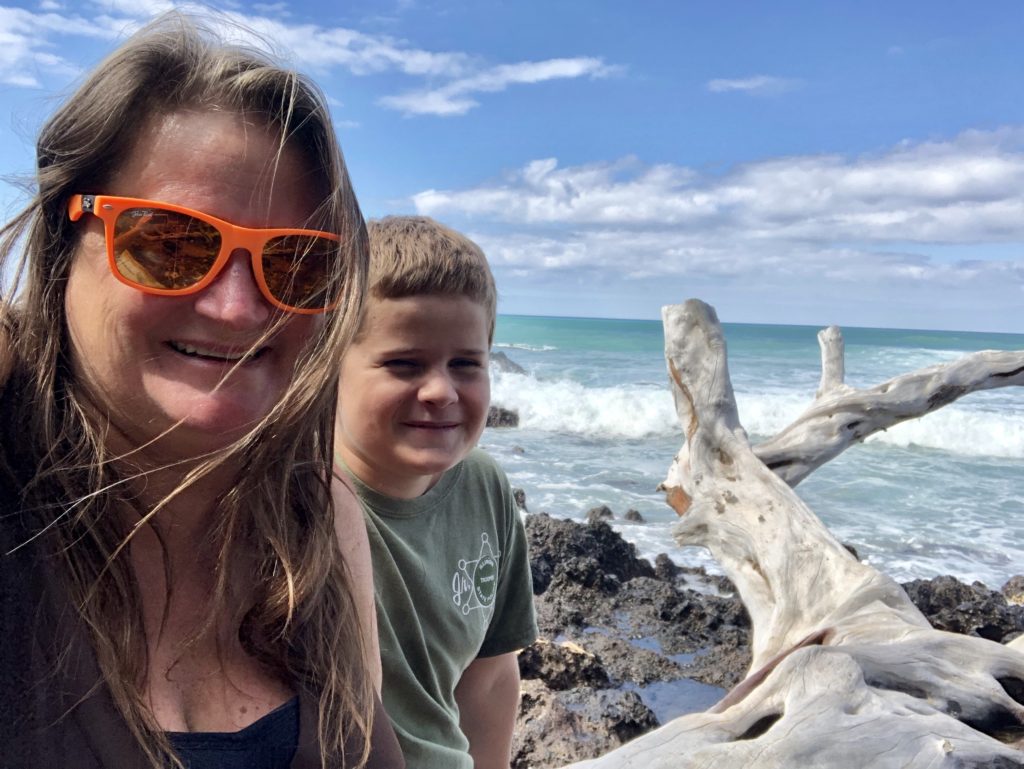We landed at the Kona airport; all of the gate seating, where passengers wait for their flights, is outside. One of many clues that you have arrived in Paradise, a place where the weather is never bad. Taking the shuttle to the rental car place, the signs were posted in English and Japanese. “Different than Chicago!” crowed Declan.
It is still the US, of course, but it feels very different. The aisles in the grocery stores are filled with Asian products, seaweed snacks and dried fish and candies with Japanese descriptions.
I have been reading this book, Moloka’i, a book of historical fiction that tells the story of a young woman who spent her whole life on the leper colony of Moloka’i. When the Europeans came to Hawai’i, the natives had no resistance to European diseases, so many thousands died of measles and smallpox and chicken pox, just like in Latin America. Leprosy came with the Europeans, and there was no known cure, so when someone was diagnosed with leprosy, they were declared legally dead and sent to the leper colony in Moloka’i. But we are not on Moloka’i, we are on the big island. We loved our time here at the Beach Shack, an Air BnB.
Even though we are only on the big island for four days, I felt like I got a bit more of a glimpse of the local culture than I did when I was on Maui. Maybe because we stayed at the Beach Shack and the tree house, even though the population of the big island is 1.4 million and the population of Maui is 166,000. Only seven thousand people live on Molokai. Driving around, we saw lots of
We picked up a couple of hitchhikers, too. The first was a young guy named Hayden from Colorado who was working at his cousin’s orchard in the Waipi’o Valley. We were on our way to the lookout, and he had hiked up to pick up a month’s worth of groceries in his backpack. “How long will you stay in Hawai’i?” I asked him. “I should really go back, but…it’s so nice here. My cousin is the happiest person I have ever known. We work in the orchard, eat the fruit from the orchard, catch fish every day, I have learned to surf, we have a musical luau every Friday which is a real sense of community…”
Lynne told me years ago that Hawaii is a good place to live if you have no money or if you have lots of money. It is hard to argue with the simple beauty of Hayden’s new-found lifestyle, but maybe it only works while you are young and healthy. We saw a homeless man at Hapuna Beach; he was sitting on a picnic table and he had blood running down his arm. The couple in front of me asked him, “Are you OK? Can we help you?” “Well, I’m OK right now, but I’m not OK in the larger sense. I don’t think there is anything that you can do to help me. They told me to get this thing taken off years ago, but I’m 72 years old and I’ve been homeless for
“Flow” was the young German hitchhiker; he had bought a ticket to Hawai’i, but had not rented a car or made any arrangements for accommodation; he just figured it out as he hitchhiked along, and it seemed to work out. I was out of my league! We picked Flow up just after lunch in Honokaa. Declan had been a bit grumpy when I stopped at Simply Natural; Liz, the owner, was very chatty. She talked to me about homeschooling her son 8-year-old son, Chester (“Hawai’i’s schools are the worst in the nation; I don’t want the government’s curriculum for Chester; I want a voice in his curriculum!” she told me. Declan perked up after playing with Chester (“he’s 1/8 Hawai’ian!”) and his cap gun and his new puppy.
Skye was the artist and architect of the www.volcanotreehouse.net. He engineered the treehouse with an eye to ecology, using repurposed materials and weaving live trees into the structure and whimsy of the house. There is an indoor fireplace, a bathroom with a floor-to-ceiling window to the rain forest, all the comforts of home. Declan didn’t even mind the lack of WiFi. I talked for a long time to Skye. “You’re giving Declan a great experience. Nowadays, I talk to kids and I wonder what they’re going to be good at, will they ever be able to make things?”
And then, of course, there were the volcanoes and the manta rays. Mahalo to Lynn and Kevin for the gift of the helicopter tour; such an amazing perspective on the recent
And we went snorkeling with giant manta rays! Apparently, it’s really unusual to be able to snorkel with giant manta rays; they are usually located very deep on the ocean floor. But apparently, with the topography of Hawai’i, there is a giant step-off from the shallows to the deep. Mantas live
On to Pape’ete!
















Sounds wonderful Julie. I’m so glad you got off the beaten path to experience the people & culture of the islands. -my spiritual home.
Julie you and Declan will revisit the remarkable visual and conceptual images you are building on your travels for years to come. A wonderfully planned itinerary….An clear expression of your zest for life….Proof that you have learned much from living.
We are incredibly lucky!!!!
much love to you and Kathy
xo
I always remember your stories about Hawaii, and our family’s various connections to the islands! xo
The way you write about a place in my heart is music to my ears. Thanks Dude!
Comments are closed.